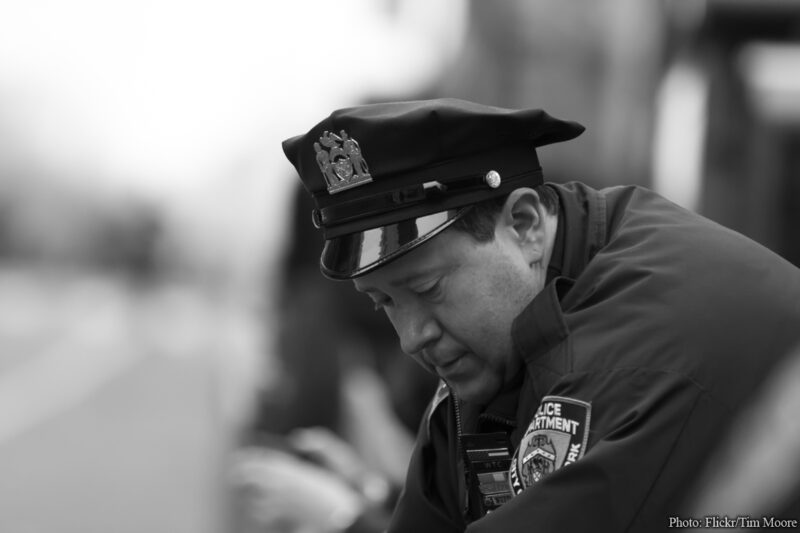
The Onion ran a funny piece last month on “The Pros and Cons of Body Cameras for Police.” One of the “cons” they listed was “Distracting to officers who must now shift focus to cinematography and mise en scène.” The joke is not without a lot of truth. One of the things we’re seeing with the photography revolution in policing is officers increasingly acting like actors, directors, and cinematographers—thinking about cameras that are on, playing to the camera, and working to shape the photographic record. And this may have important consequences for policing.
A stellar example of what I’m talking about can be found in the case of a man named Marcus Jeter, who was pulled over, beaten, and arrested by a Bloomfield, New Jersey officer in 2012. The officer who is beating Jeter can be heard on video yelling, “Stop resisting! Stop resisting! Why are you trying to take my fucking gun! Get off my gun!” In the officer’s dashcam video, it is unclear whether Jeter was, in fact, resisting and/or trying to take the officer’s gun, and Jeter was charged with a number of criminal counts including assault. Internal affairs cleared the involved officers of any wrongdoing and prosecutors offered Jeter a plea deal of 5 years in prison.
Fortunately for Jeter, a second video surfaced showing the incident from another angle. The video was from the dashcam on another patrol car that arrived at the scene as backup, and which prosecutors said was not initially provided to them by police. In the second video, it is clear that Jeter had his hands in the air from the beginning before being attacked by the officer. (The police officer was charged with aggravated assault, and he and another officer also faced charges including conspiracy and falsifying reports. A third officer pleaded guilty to tampering and retired. All charges against Jeter were dropped.)
By falsely shouting that Jeter was resisting and trying to take his gun, even as he beat the motorist, the officer was clearly acting for the cameras, aware that he was playing a role in a public drama where later interpretations of what took place would be contested. And his aggressive physical behavior was matched by an equally aggressive attempt to define how his own actions would be interpreted. He almost succeeded.
Officers become not only actors, but also directors. In some departments that wear cameras, I have been told, when officers are dealing with a situation some of them will move to the center of the action to respond, while one will remain on the periphery to capture a broader view of the scene on his or her camera.
Sometimes officers also want to yell “cut!” as I discussed in this post, which is why it’s important that policies govern when officers stop recording as well as start.
At a conference last week, I was talking to Justin Ready, an Arizona State University criminologist who has done a number of studies of police and body cameras, and he mentioned another example of this. I pulled out my voice recorder and he told me about it:
The officers start out with this technology, but over time, they start to innovate. What we’re finding in Mesa is—it started out with a small group of officers who actually started to create a scripted dialogue with the camera. They would start to make statements into the camera, which would jog their memory for writing up reports, but also kind of explain why they’re acting the way they are. They’ll narrate not only their own behavior, but more importantly when they’re observing behavior on the street—say a situation where they might want to engage, or perform a stop and frisk, or some type of detention situation. They’ll talk to the camera about how the individual is acting at different stages, and actually explain, “Okay, this behavior right here is suspicious, or this provides reasonable suspicion in this situation,” which then provides an ongoing dialogue about their thought process in the stages leading up to an actual interaction with a citizen.
Ready says this helps officers “document the broader context of their situation” and avert what is known in the criminology literature as “split-second syndrome.” That is when an officer’s behavior in the seconds before a shooting is later scrutinized without any recognition of the broader context of, as Ready put it, “how the incident was precipitated and the series of steps that led up to that lethal deployment of force.” Even if a shooting is deemed justifiable within the moment, Ready says, the broader context can raise questions: “Should they have called for backup? Did they corner themselves into a situation where lethal force was necessary—was it avoidable at three stages, two stages back, before they initiated contact?”
One of the potential implications of such narration is that it may increase the likelihood that ambiguous video footage will be interpreted through the officer’s eyes. Sometimes this might be fair, as the key question in judging an officer’s use of force is whether it was reasonable given how the officer experienced things in the moment. But as the behavior of the New Jersey officers in the Jeter case reminds us, it also creates a real potential for officers to misguide viewers.
On the other hand, Ready told me that officers’ dialogues with their video audiences can also serve
as a check on the officer’s thought process. Instead of engaging in behaviors that might be routine through training, it might allow him to think much more carefully about his actions in the stages leading up to an encounter, so that he’s not kind of passively thinking based on past encounters, but it’s a much more active cognitive process.
Sociologists and others who think deeply about privacy have long recognized that one of the effects of prolonged external surveillance is that we internalize it. Conscious that others are watching us, we begin to watch ourselves through their imagined eyes. This is one of the reasons that it’s important that a free citizenry not be subject to constant surveillance—because that kind of self-monitoring can be debilitating, and a free people needs refuge from the critical eye of the community. On the other hand, when a police officer is wielding brutal or deadly force under authority of the community, it’s a very good thing if that officer feels the eye of that community upon him or her at those times—and the more that’s internalized the better. In many ways that dynamic is the whole point of police body cameras and the rights of citizen witnesses to record: deterring bad behavior by police.
Over time, I expect that these kinds of “acting and directing” behaviors by police will become more widespread—and also more subtle and sophisticated. As I’ve argued before, humans are social animals, keenly conscious of who is or may be watching us at any given time. If you’re a police officer dealing with a citizen, your audience is that citizen, maybe some other officers, or maybe some bystanders. But if you’re on video, now you don’t know who your audience is: it could be your supervisor, a prosecutor, a judge, a jury, an entire community, or the entire nation or world. It’s natural that people will adjust their behavior to account for those potential wider audiences.
And we humans are not only social animals, but also clever ones. We are not sheep, and we don’t just plod along when technology changes things around us; we perceive what is happening and we change our behavior in response. In the face of video recording, some will try every tricky technique to manipulate the new reality.
Of course, it’s not going to just be police officers who do these things—all parties involved in public incidents may do so. As one former police chief advised officers on a police web site,
Some bad guys know they have an audience and will keep their threats quiet. They might hiss a threat into your ear or when they are turned away from a crowd or camera. Conversely, an arrestee with a flair for the dramatic will yell for the sake of the crowd about how much pain they are in.
(This advice can be found here; but see also this critical take on the piece.)
No doubt academic dissertations are being or will soon be written on police actions as performance. But one implication of all this is that it will be important in the future that we all learn to be more sophisticated in interpreting video evidence (as I also discussed here). All the world’s a soundstage, and we are sometimes players—and, often, directors, viewers, and critics.


